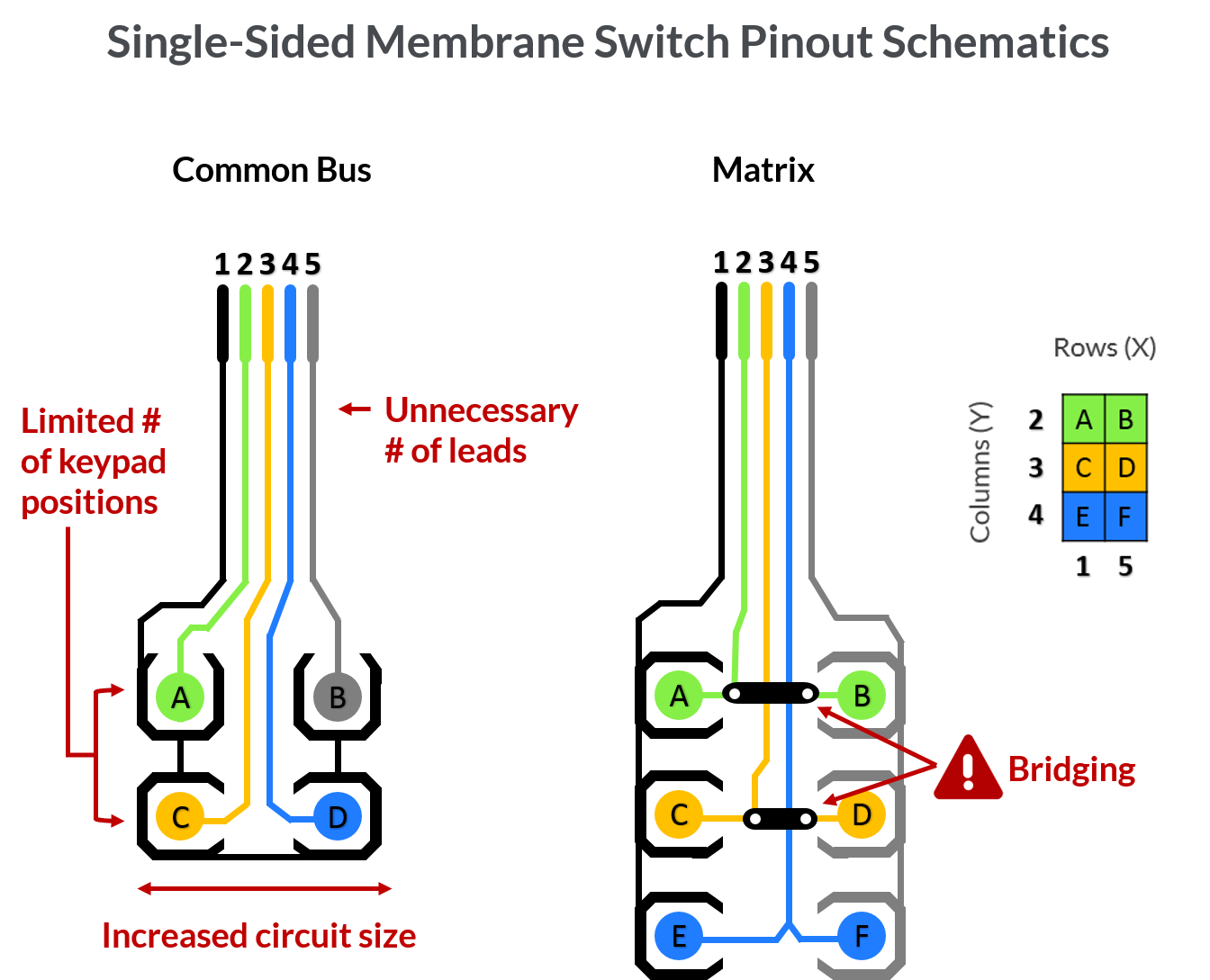Everything you need to know about membrane switch customization
Wiki Article
Everything About Membrane layer Switch Over: A Comprehensive Overview for Beginners
Membrane switches are crucial elements in modern-day electronic devices, supplying an unique user interface for user interaction - membrane switch. Their layered building, including overlays and conductive traces, supplies performance and toughness. Unlike typical mechanical switches, membrane buttons provide a sleek design and adjustable alternatives. Understanding their crucial features and advantages can change item style. The complexities of their application and design factors to consider warrant further exploration.What Is a Membrane layer Change?
A membrane button is a kind of electrical switch that consists of a versatile membrane layered over a published circuit card. This design enables a streamlined and compact interface, typically made use of in various electronic tools. Membrane buttons are typically located in customer home appliances, medical equipment, and industrial equipment due to their sturdiness and resistance to ecological factors.The building typically includes multiple layers, such as graphic overlays and adhesive backing, which offer tactile responses and protect the wiring beneath. The operation of a membrane layer switch is initiated when stress is related to the surface area, completing an electric circuit.These buttons are valued for their versatility, allowing customized styles and printed graphics that accommodate certain interface. Their inconspicuous nature reduces area requirements, making them excellent for applications where standard switches might not fit. In general, membrane switches offer a practical and visual remedy for modern-day digital gadgets.Secret Parts of Membrane Switches
Membrane switches over comprise several key elements that add to their performance and performance. The top layer, referred to as the overlay, supplies the interface and is usually published with graphics or icons. Below the overlay lies a spacer layer, which divides the conductive components and avoids inadvertent activation. The next crucial part is the graphic layer, which enhances visual appeals and ensures the durability of the design.Conductive traces, generally made from products like silver or carbon, are published on the circuit layer. When stress is put on the overlay, these traces come right into contact, finishing the circuit. Additionally, a backing layer uses architectural support and can be made from materials such as polyester or polycarbonate. Together, these components produce a reliable, easy to use user interface appropriate for numerous applications, from house devices to commercial equipment. Comprehending these components is crucial for anybody interested in membrane switch technology.Just How Membrane Layer Switches Over Work
Comprehending just how membrane switches over function is essential for appreciating their extensive use in various devices. A membrane layer switch operates with a collection of layers, consisting of a graphic overlay, spacer, and a circuit layer. When pressure is put on the overlay, it presses the spacer layer, allowing the circuit layer to make get in touch with and finish an electric circuit. This action sends a signal to the gadget, triggering a feedback, such as transforming on a light or turning on a function.Membrane switches can be designed with numerous attributes, including responsive feedback, backlighting, and custom graphics, enhancing customer interaction. Their construction enables a covered layout, safeguarding the inner components from dirt, wetness, and pollutants. This toughness makes them suitable for varied applications, from customer electronics to industrial devices. Generally, the simpleness and effectiveness of membrane layer switches add to their appeal in modern-day innovation.Advantages of Membrane Layer Switches Over Mechanical Switches
While mechanical switches have actually long been a staple in many devices, membrane layer changes deal distinctive benefits that make them progressively appealing. One significant advantage is their slim account, enabling even more portable styles and greater flexibility in item advancement. Additionally, membrane layer switches over feature a consistent surface, which boosts visual allure and streamlines cleansing, making them ideal for settings where health is critical.Another benefit is their resistance to dirt and moisture. Unlike mechanical switches, which can be jeopardized by ecological elements, membrane layer switches supply a closed user interface that protects against impurities - membrane switch. Furthermore, membrane buttons commonly have a longer life-span because of fewer relocating parts, causing boosted longevity and reliability.Cost-effectiveness is additionally a noteworthy benefit, as membrane switches can be created wholesale with lower manufacturing expenses. These factors combine to place membrane buttons as a sensible option to conventional mechanical alternatives in numerous applicationsCommon Applications of Membrane Layer Switches
Membrane layer switches are widely used in numerous industries, especially in consumer electronics and industrial control panels. In customer tools, they give a sleek, straightforward user interface, while in commercial setups, they enhance resilience and performance. Comprehending these applications highlights the flexibility and practicality of membrane switches in modern technology.Consumer Electronics Tools
As consumer electronic devices continue to develop, membrane buttons have actually ended up being a popular selection for a selection of devices because of their versatility and smooth layout. These switches are generally found in smartphones, tablets, and remote controls, where space is minimal and aesthetics matter. Their reduced profile and personalized layouts allow suppliers to produce easy to use user interfaces that boost the general customer experience. Additionally, membrane buttons are usually utilized in home appliances such as microwaves and coffee manufacturers, supplying instinctive control alternatives while standing up to dampness and dust. The toughness and integrity of membrane switches over make them appropriate see it here for everyday consumer items, making certain durability and consistent performance. Overall, their assimilation in consumer electronic devices shows a blend of functionality and contemporary style.Industrial Control Panels
The applications of membrane layer changes extend past consumer electronic devices, locating substantial use in industrial control panels. These switches are preferred for their longevity and resistance to severe atmospheres, making them optimal for manufacturing and procedure control setups. They offer a trusted interface for operators to control equipment, screen procedures, and change setups. Membrane layer buttons can be customized to match particular functional demands, incorporating functions like backlighting and tactile feedback, boosting individual experience. Their inconspicuous design permits assimilation right into numerous devices, while their ability to endure spills, dust, and severe temperature levels guarantees durability. On the whole, membrane buttons add to safe and effective operation in commercial applications, demonstrating their convenience and performance sought after atmospheres.Considerations for Creating Membrane Switches Over
When designing membrane layer switches, selecting the ideal materials is necessary to guarantee longevity and capability. Furthermore, recognizing layer discover this info here arrangement techniques can greatly impact the button's performance and customer experience. These factors to consider play an important role in producing effective and trusted membrane button layouts.
Material Option Significance
Product option plays an important duty in the style and capability of membrane switches. The chosen products straight affect the switch's toughness, tactile reaction, and general aesthetic. Secret considerations consist of the substrate, which must supply structural stability while enabling for adaptability, and the graphic overlay, which requires to be immune to use and ecological factors. Conductive materials should assure trusted electrical performance, while adhesives need to offer strong bonding without compromising the switch's procedure. Furthermore, compatibility with manufacturing procedures and end-user atmospheres is vital; products need to stand up to varying temperature levels, humidity degrees, and chemical exposure. Ultimately, ideal material option not just enhances the membrane layer switch's efficiency but additionally contributes to its long life and this link individual complete satisfaction, making it a vital aspect of the style process.
Layer Arrangement Techniques

Regularly Asked Questions
How Much Time Do Membrane Layer Switches Normally Last?
Membrane switches usually have a lifespan of 1 to 5 million cycles, relying on usage and ecological conditions. Aspects such as design high quality and operating regularity considerably affect their resilience and total performance durability.
Can Membrane Layer Switches Be Personalized for Particular Designs?
Membrane layer buttons can undoubtedly be personalized to accommodate specific layouts, permitting diverse shapes, shades, and performances. This flexibility enables suppliers to customize these switches to meet unique aesthetic and operational demands successfully.What Materials Are Utilized in Membrane Change Building And Construction?
Membrane switches are normally created making use of materials such as polyester, polycarbonate, and glue layers. These materials supply versatility, longevity, and resistance to ecological factors, making sure the buttons function successfully in numerous applications and problems.
Are Membrane Changes Water-proof or Immune to Wetness?
Membrane layer buttons can be designed to be moisture-resistant, utilizing specialized products and coatings. However, their water resistant capacities rely on building and construction quality and particular applications, making it vital to evaluate demands for suitable efficiency in numerous environments.How Are Membrane Switches Fixed if Harmed?
Fixing broken membrane switches generally involves changing the influenced layer or circuit. Professionals might likewise apply conductive adhesive or use specialized fixing packages, making sure performance is brought back without complete replacement of the whole button assembly. Unlike conventional mechanical buttons, membrane buttons offer a smooth design and personalized choices. A membrane button is a kind of electrical button that is composed of a flexible membrane layered over a printed circuit board. The operation of a membrane layer switch is initiated when stress is applied to the surface, finishing an electrical circuit.These switches are valued for their adaptability, allowing customized designs and published graphics that cater to details individual interfaces. While mechanical switches have actually long been a staple in many tools, membrane switches over offer distinctive advantages that make them significantly appealing. Membrane buttons usually have a longer lifespan due to less moving parts, resulting in boosted toughness and reliability.Cost-effectiveness is also a significant benefit, as membrane layer buttons can be produced in mass with lower manufacturing prices.Report this wiki page